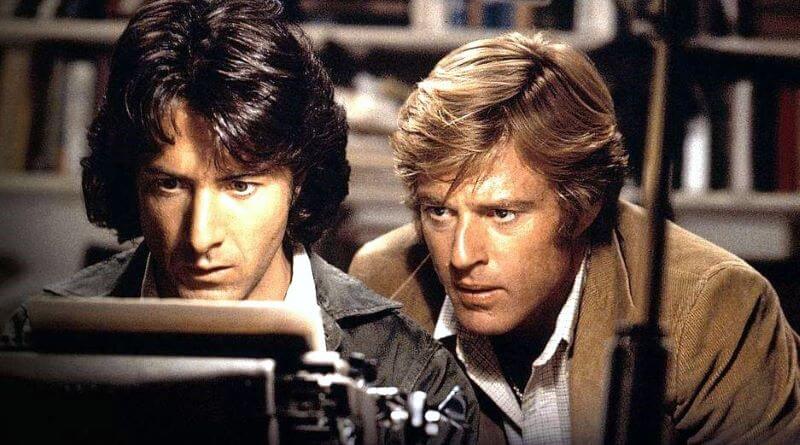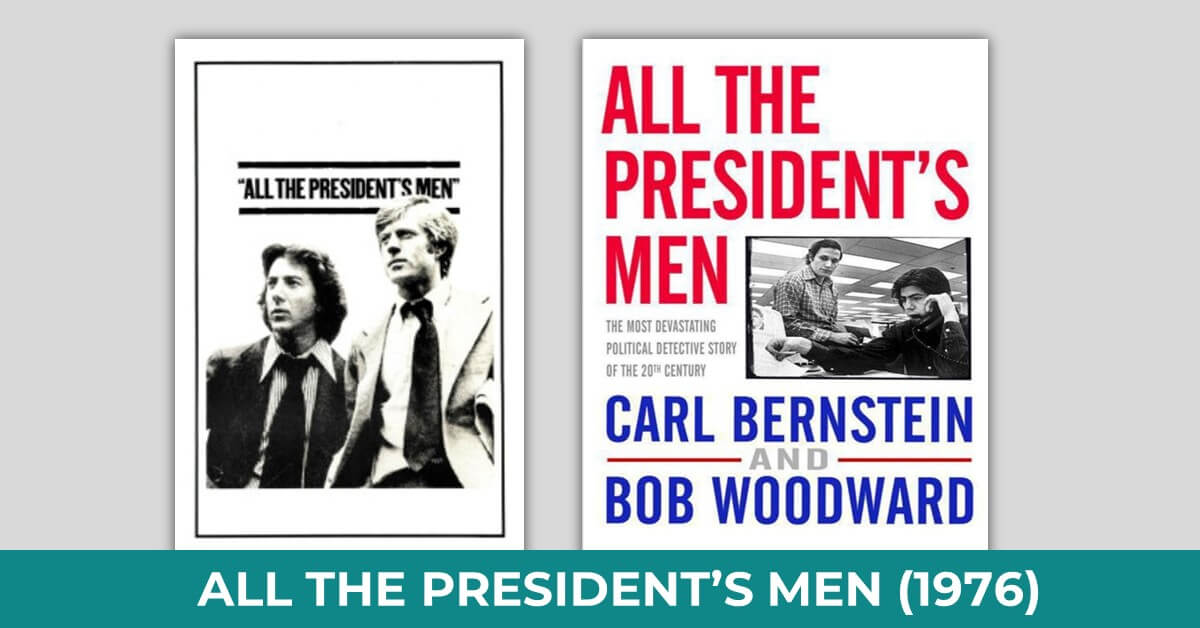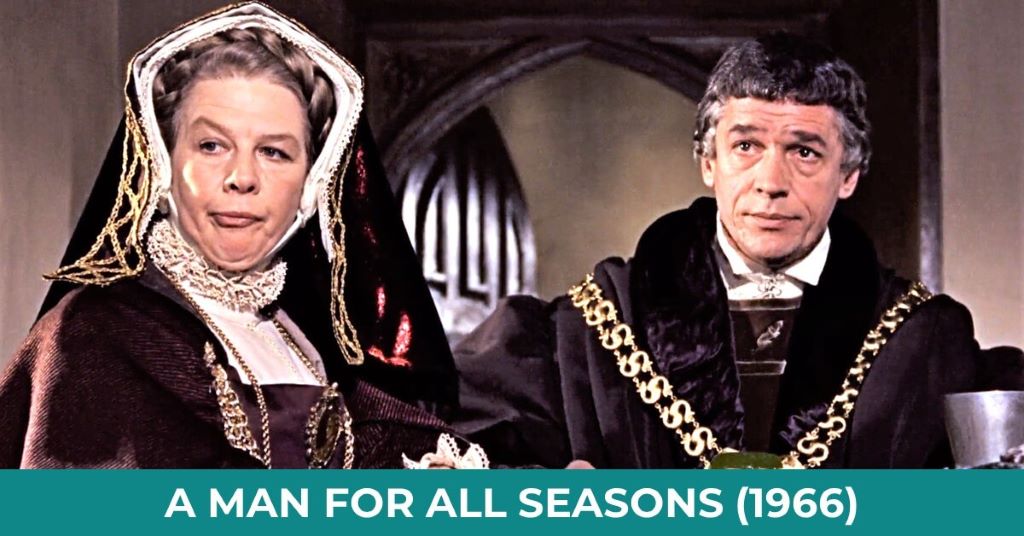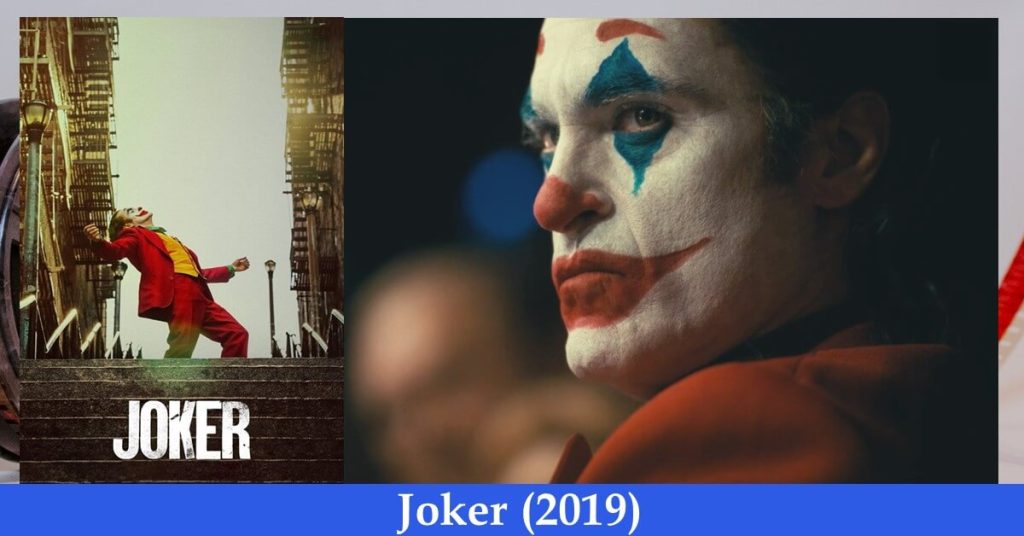Last updated on September 19th, 2023 at 08:43 am
All the President’s Men 1976 is an American political thriller film based on a non-fiction book by two The Washington Post journalists, Bob Woodward and Carl Bernstein, of the same name on the Watergate scandal.
The film shows the power of investigative journalism responsible for searching for political truth and uncovering the corruption of the Richard Nixon administration, especially the Watergate scandal of 1972 which eventually put an axe on his foot to bring him down from power as the most powerful man who was on the go to sabotage his political opponents, the Democrats.
Successful though as President who was able to solve the communism problem of China and Russia, Nixon’s administration was riddled with illegal activities, bugging the Democratic National Committee office is just many of them which turned out to be Achilles’ heel.
Due to fearless journalism premised on freedom of press and the public protestation the President who won the highest margin of vote was compelled to resign which would have been impossible in many other countries. But still, the role of an internal informant like “Deep Throat” is pivotal for incidents as significant as this.
Directed by Alan J. Pakula and written by William Goldman, starred by Robert Redford (Bob Woodward), Dustin Hoffman (as Carl Bernstein), and Jason Robards (as Ben Bradlee), the movie is successful one with a 70.6 million box-office earning of 8.5 million investment that won 4 Academy Awards including the Best Picture.
All the President’s Men also won the Kansas City Film Critics Circle Awards, National Board of Review Awards, National Film Preservation Board, National Society of Film Critics’ Awards, New York Film Critics Circle Awards and Writers Guild of America Awards, and the film was selected for preservation in the United States National Film Registry by the Library of Congress as being culturally, historically, or aesthetically significant in 2010. It is one of the 101 best films of 100 years I have been reviewing.
Background: Watergate
Watergate is a major political scandal involving the administration of President Richard M. Nixon in the USA that originated with the burglary and wiretapping of the Democratic National Committee headquarters in the Watergate office- apartment in Washington D.C., on June 17, 1972, six months before Nixon’s second term election. The scandal later engulfed President Richard M. Nixon and many of his supporters in a variety of illegal acts, and culminated in the first resignation of a US president, because of his role in covering up it.
The burglary took place in the middle of the night of June 17, 1972, by five security intelligence personnel four (Bernard L. Barker, Virgilio R. Gonzalez, Eugenio R. Martinez, The Retired and Frank A. Sturgis) of whom had been in active service in Central Intelligence Agency (CIA) in Cuba, while the fifth, James W. McCord, was the security chief of the Committee to Re-Elect the President (CRP) of the Republican party led by John Mitchell, Nixon’s former attorney general.
Their arrest eventually exposed a White House-sponsored plan of espionage against Nixon’s political opponents and a trail of involvement that led to many of the highest officials in the USA, including his attorney-general John Mitchell, White House Counsel John Dean, White House Chief of Staff H. R. Haldeman, White House special assistant on domestic affairs John Ehrlichman, and President Nixon himself.
The arrest was reported in the Washington Post the next morning in an article written by Alfred E. Lewis, Carl Bernstein, and Bob Woodward. Carl Bernstein and Bob Woodward were a pair of relatively unexceptional young and low-ranked reporters referred to cover minor criminal activities.
Soon after the burglary, from the address books left by two burglars, Woodward and Bernstein discovered the involvement of two high officials in the burglary: Howard Hunt, a former high-ranking CIA officer only recently employed to the staff of the White House, and G. Gordon Liddy, a former FBI agent recently employed in CRP.
Though not many journalists and newspapers pursued the scandal, Bernstein and Woodward were in a constant attempt to know the source of money of a cheque issued against Barker, one of the five burglars.
Meanwhile, the conspirators destroyed evidence. Jeb Stuart Magruder, deputy campaign director of the Committee to Re-Elect President (CRP) burned transcripts of wiretaps from an earlier break-in at the DNC’s offices. On June 23, 1972, the president ordered the FBI to stop its investigation of the burglary on 23 June 1972 to cover up the White House connection.
Throughout the 1972 election campaign, an informant whom Woodward’s colleague named as “Deep Throat”, leaked information to Woodward related to the CRP committee’s irregularities. 30 later the anonymous informant had been known to be W. Mark Felt, Sr. an FBI deputy director. Some even believed “Deep Throat” to be Nixon’s wife.
They kept up a steady discovery indicating the direct involvement of Nixon’s people in Watergate bugging activities, and the ploy had been financed through illegally laundered campaign contributions, and, in a news circulation of October 10 front-page article written by Woodward and Bernstein involving the White House as a part of “a basic strategy of the Nixon re-election effort.”
Finally, on April 30, 1973, nearly a year after the burglary and arrest and following a grand jury investigation of the burglary, Nixon accepted the resignation of H. R. Haldeman, assistant to the President and White House Chief of Staff, and John D. Ehrlichman, assistant to the President for Domestic Affairs and announced the dismissal of John W. Dean III, counsel to the President.
US attorney general Richard Kleindienst also resigned. The new attorney general, Elliot Richardson, assigned Archibald Cox, a special prosecutor from Harvard Law School to conduct a full-scale enquiry into the Watergate break-in.
In May 1973 the Senate Select Committee on Presidential Activities opened hearings, with Senator Sam Ervin of North Carolina as chairman. A series of startling revelations followed. The counsel to President Dean testified that the campaign director of CRP John N. Mitchell had ordered the break-in and that a major attempt was underway to hide White House involvement. He claimed that the president had authorized payments to the burglars to keep them quiet which the Nixon administration vehemently denied this assertion.
On July 16, 1973, Alexander P. Butterfield, deputy assistant to the President; aide to H. R. Haldeman told the committee that Nixon had ordered a taping system to be installed in the White House to automatically record all conversations; what the president said and when he said it could thus be verified. Cox immediately subpoenaed eight relevant tapes to confirm Dean’s testimony.
Nixon refused to release the tapes, claiming they were vital to the national security. US District Court Judge John Sirica ruled that Nixon must give the tapes to Cox, and an appeals court upheld the decision.
Nixon held firm. He refused to release the tapes and, on Saturday, October 20, 1973, ordered the new attorney general, Elliot Richardson to dismiss Cox. Richardson refused and resigned instead, as did Deputy Attorney-General William Ruckelshaus. Nixon then ordered the third-most-senior official at the Justice Department, Solicitor General Robert Bork, to fire Cox.
Bork followed the President’s order. the Solicitor General discharged Cox. The series of events and the public protestations that took place on the day led to the “Saturday night massacre”.
In response, Nixon appointed another special prosecutor, Leon Jaworski, a Texas lawyer, and gave the tapes to Sirica. Some subpoenaed conversations were missing, and one tape had a mysterious gap of 18y minutes. Experts determined that the gap was the result of five separate erasures.
In March 1974 a grand jury charged the campaign director of CRP John N. Mitchell, H.R. Haldeman, Ehrlichman, assistant to the President for Domestic Affairs, and four other White House officials for their part in the Watergate cover-up and named Nixon as an “unindicted co-conspirator”. The following month on Jaworski’s request Nixon released written transcripts of 42 more tapes of White House conversations.
The conversations revealed a devastating concern over punishing political adversaries and thwarting the Watergate investigation. In May 1974, Jaworski requested 64 more tapes as evidence in the criminal cases against the indicted officials. Nixon refused; but on July 24, the Supreme Court voted 8-0 that Nixon must turn over the tapes.
If you shoot too high and miss, everybody feels more secure.
Deep Throat, All President’s Men 1976
The investigation also discovered that the Nixon administration had petitioned large sums slush fund illegal campaign contributions, and used them to finance political espionage and to pay more than $500,000 to the Watergate burglars.
Moreover, White House aides testified that in 1972 they had fabricated documents to make it appear that former President John F. Kennedy had been involved in the 1963 assassination of President Ngo Dinh Diem of South Vietnam, and had written false and slanderous documents accusing Senator Hubert H. Humphrey of moral indecencies.
In the meantime, Nixon won his second term in a landslide in the presidential election in 1972. Nevertheless, throughout this period of revelations on the Watergate scandal, Nixon’s support in Congress and popularity nationwide steadily eroded. On August 5, 1974, three tapes revealed that Nixon had ordered the Federal Bureau of Investigation to stop investigating the Watergate break-in on June 23, 1972. The tapes also showed that Nixon himself had helped to direct the cover-up of the administration’s involvement in the affair.
Rather than face a vote in the House of Representatives, which almost certainly would have resulted in his impeachment, Nixon resigned on August 9. He was the first US president to resign from office. A month later his successor President Gerald Ford forgave him for all the crimes he might have committed while in office.
Storyline
On June 17, 1972, five buglers entered the DNC in the Watergate building office in Withington D.C. while one man was on guard in an adjacent hotel. Being alerted the police were on their way also. Alarmed, unit one inside the office turned off its walkie-talkie making unit 2 difficult to reach while policemen entered the 6th floor of the building. They were wiretapping the telephone line. The five were arrested.
Informed, Woodward from The Washington Post reached the Democratic National Committee (DNC) headquarters. Unusual though the burglars had their own counsel. He found that the burglars had 814, 230, 215 and 234 dollars most of it was in 100$ bills in sequence.
Four of them are Cuban Americans–Bernard L. Barker, Virgilio R. Gonzalez, Eugenio R. Martinez and Frank A. Sturgis–and the fifth, James W. McCord, Jr., the retired security consultant of CIA, and the security chief of the Committee to Re-Elect the President (CRP, later known popularly as CREEP), which was presided over by John Mitchell, Nixon’s former attorney general.
Present in the court, Woodward got to know Barker, an anti-communist. Bernstein and Woodward were asked to find out the reason for the burglary. Woodward was informed from the police headquarters that they found a note of two burglars’ address books with initials “HH” at “W.H”, referring to Howard Hunt, consultant to the White House.
When Woodward dialled the White House, he was told to check in Charles W. Colson’s office, but informed of his absence and was told to try him with Mullen Firm & Company where he worked as a writer.
Woodward found Howard Hunt in Mullen Firm. But when asked how his phone number and address ended up in one of the burglars’ address books he refused to comment, as the matter, he said, was with adjudication. Woodward then phoned Robert F. Bennett, president of the Mullen public-relations firm, the son of Republican Senator Wallace F. Bennett of Utah, and said, “I guess it’s no secret that Howard was with the CIA.” clearly Hunt worked for CIA until 1970, from 49, found to be involved in the burglary, worked as a consultant to Charles W. Colson, special counsel to the President.
Bernstein then went to meet Sharon Lyle who worked with Colson. Sharon revealed to Bernstein about Howard Hunt to be involved in investigative work on Teddy Kennedy and would brow books from the White House library and the Library of Congress. When called to the White House library, the lady on the phone informed to have known Howard first but later changed her mind to say to had known him never.
When Bernstein denied information from the White House library, Woodward phoned Kenneth W. Clawson, deputy director of communications, at the White House and said that the librarian at the White House office denied knowing Howard Hunt.
Clawson called back verification only to inform that she denies the conversation ever to have taken place between Bernstein and her. Then they both decided to check with the Library of Congress to request material in the library, but they were turned down by the librarian saying all White House transactions are confidential.
Speaking to the reporters in a hallway, rather than his office, a librarian informed them politely that White House transactions were confidential. Eventually, the reporters found a more cooperative clerk and spent the afternoon in the reading room sorting through thousands of slips of paper—every request since July 1971, when Hunt was hired by the White House. Though they found nothing in there, they turned to a familiar guy from the White House who gave them notes saying the White House showing special interest in Kennedy.
After having checked, Benjamin C. Bradlee Executive Editor, denied running the story implicating Howard and told them that it lacked strong evidence or harder information. As a last refuge, Woodward turned to, Deep Throat, a secret informant from the CIA who agreed to talk to him secretly.
When Woodward said that he heard about William O. Bittman, Hunt’s attorney, who had received $25,000 in cash in a brown envelope to take Hunt’s case, Deep Throat said, “Follow the money”. Bittman was a highly respected member of the bar, a partner in the prestigious firm of Hogan and Hartson, and a former Justice Department attorney who had successfully prosecuted Jimmy Hoffa, the former president of the Teamsters’ Union.
Bernstein found out about 15 phone calls made to the Committee to Re-Elect the President (CRP) by burglars and 89,000 $ transacted to a Mexican lawyer. Bernstein had to find out Dardis, the state attorney of Florida, who subpoenaed the phone records of the bugler. He obtained the phone and money record of Barker.
He found Barker was paid 25,0000$ by Kenneth H. Dahlberg, Midwest Finance Chairman, CRP and he turned out be from Minnesota. Over the phone, Dahlberg told that as a finance chairman, he turned over all the money, as he did not want to carry cash on his home in Miami, he had the money exchanged for the cashier’s check which he gave then to Maurice H. Stans, the head of Finance for Nixon, CRP; former secretary of commerce which wind up in the account of Barker.
The next day The Washington Post ran the story as “Bug suspects got campaign funds”. To unearth the financial irregularity, the key to everything, Bernstein and Woodward were on the run to elicit information from CRP employees. However, they realised that Kay Eddy, an employee of The Washington Post, goes out with a man who works with the CRP with whom she was engaged once. From her, they got a list of the people who work with CRP.
The list gave information about Brenda Jaspers working under John N. Mitchell, campaign director, CRP; former Attorney General. They are on the run to find out how the money ends up in the burglar’s account from Maurice Stans. To do so, they reached Hugh W. Sloan, Jr., treasurer, CRP, a former aide to Haldeman who worked under Stans. When Sloan did not disclose much, they went to many employees to inquire about how many people were involved in the slush funds, but none opened up.
Finally, Bernstein found a lady, Sloan’s bookkeeper. Though Government Accountability Office (GAO) found there 350,000$ in CRP funds, she reveals that it was not just 350,000 but 6 million dollars. She said it was paid out to a list of 15 names, but the list was destroyed.
She gave them 3 initials of the names of the men who were working under Mitchel and received the funds as “L”, “P” and “M” who were responsible for the money used. they confirm “L” stand for Liddy, Gordon Liddy, “P” stands for Porter, Herbert L. Porter, scheduling director, CRP, and “M” stands for Magruder, Jeb Stuart Magruder, deputy campaign director of CRP, former Haldeman aide and deputy director of White House communication, who was temporary head of the CRP before Mitchel. They confirmed that Porter received money from the lady.
Later Bernstein got a call-to-call Alex Shipley who was asked by an army buddy Donald Segretti to join a group of lawyers for Nixon’s campaign in 1971 to sabotage the Democratic Candidates. Bernstein went to interview Segretti and wanted to know about the Canuck letter sent to a daily newspaper from Manchester, The New Hampshire Union Leader where he claimed Muskie, the Democratic Party’s candidate for Vice President, made disparaging remarks on Canadians.
However, a reporter from The Washington Post, named Sally informed Woodward and Bernstein that Deputy Director of Communications of the White House, Kenneth W. Clawson wrote the letter that sabotaged Muskie’s candidacy. The authorship was later confirmed, a combined work of Segretti and Clawson.
Later Woodward found out that the secret cash fund was financed Segretti who was hired by Dwight L. Chapin, deputy assistant to the President and appointments secretary, who was hired by H. R. Haldeman, assistant to the President, White House Chief of Staff. The five, Liddy, Porter, McGruder, Herbert W. Kalmbach, deputy finance chairman of CRP and Haldeman controlled the funds.
As the executive editor of The Washington Post, Benjamin C. Bradlee still refused to run the story on Haldeman, the most second important man in the country of conducting a conspiracy from inside the White House to be the fifth man who controlled the funds.
But to confirm Haldeman’s involvement, Bernstein went to contact Rosenfeld who was a lawyer in the Justice Department. Bernstein asked the lawyer point-blank if Haldeman was the fifth person in control of the slush fund. He somehow got it confirmed.
The next day the paper ran the story ” Testimony Ties Top Nixon Aid To Secret Funds”. But it happened that Sloan’s lawyer denied Sloan giving any testimony implicating Haldeman making the report unsubstantiated. Though he later phoned Bernstein to say that he would have named Haldeman to the Grand jury had anyone asked. Ronald L.
Ziegler, press secretary to the President denigrated the report and linked it to shabby journalism. Nixon’s campaign manager Clark McGregor blames the report as innuendo from third-party hearsay, unsubstantiated charges, and anonymous sources with scary headlines, to give the direct connection between the White House and the Watergate scandal. He denied the charge as hypocrisy.
But instead of making any statement or rejoinder Ben, stood by the information gathered by Woodward and Bernstein. “Deep Throat” revealed to Woodward that it was a Haldeman operation. The whole business was run by Haldeman, the money, everything. It won’t be easy getting at him. He was protected. Mitchell started doing covert stuff before anyone else.
The list is longer than anyone can imagine. It involves the entire U.S. Intelligence community FBI, CIA, and Justice. The cover-up had little to do with Watergate. It was mainly to protect the covert operations. It leads everywhere. “Deep Throat” more said that their life is in danger because they are under surveillance and bugging.
The cover-up had little to do with the break-in. It was to protect covert operations and covert activities. Bach at The Washington Post, Woodward and Bernstein hammer doggedly at their typewriters at the end of the film writing report on the involvement, guilty and incarceration of the President’s men in the year of 1973-1974, until 9th August 1974 when President Nixon finally resigned from the office.
By late February 1974, the special Watergate prosecution force had obtained guilty pleas from Jeb Magruder, Bart Porter, Donald Segretti, Herbert Kalmbach, Fred LaRue, Egil Krogh and John Dean. Eight corporations and their officers had pleaded guilty to charges of making illegal contributions to CRP.
Influence of All the President’s Men 1976
If All the President’s Men were inspired by its predecessor All the Kings Men (1949), it has definitely inspired numerous people to investive journalism across the globe. Many films or documentaries on the corrupt rules have been made or named after All the President’s Men (1976).
In 2016 Germany released its Alles was wir hatten (Germany, 2016) – This is a German film that was inspired by All the President’s Men and follows a group of journalists as they uncover a scandal in modern-day Germany. American political drama film All the King’s Men (2006) talks about Willie Stark, an idealistic lawyer, who becomes the governor of Louisiana, and embroils himself in corruption as he rises to power.
The 2021 All the Prime Minister’s Men, is an Al-Jazeera investigative documentary conspiring in English against the regime of Prime Minister Sheikh Hasina of Bangladesh. published by the Qatar-based international media Al Jazeera, it alleged corruption against powerful political and military figures in Bangladesh.
The movie All the President’s Men was not only a critical success but also had a significant impact on American society. The movie inspired a new generation of journalists to pursue investigative reporting and hold those in power accountable. It also helped to restore the public’s faith in the media as a reliable source of information. The movie’s legacy continues to this day, as it is considered one of the greatest political thrillers ever made.

What to Consider
The Watergate scandal was a defining moment in American political history. The scandal involved the illegal break-in of the Democratic National Committee headquarters at the Watergate office complex in Washington, D.C. in 1972.
The break-in was carried out by operatives of the Committee to Re-elect the President (CREEP), which was working for the re-election of President Nixon. The subsequent cover-up by the Nixon administration led to the resignation of President Nixon in 1974, making him the first and only U.S. President to resign from office.
All the President’s Men showcases the power of journalism and of course investigative journalism in that sense. Today the world is flooded with yellow journalism where the tyranny of the yellow journalists is unprecedented.
This kind of journalism is motivated to a section of motivated people who aim to suppress the voice of liberal minds while other kind of yellow journalism terrorise the innocent section of citizens and demand ransom as if they are captivated by this section of journalists.
Citizen journalism is on the rise. Citizen journalism is conducted by people who are not professional journalists but who disseminate information using Web sites, blogs, and social media such as Facebook or Twitter and YouTube where most of the news can be categorised into yellow journalism due to their contents.
This type of content is most directed to click-bate with sensationalised and misleading titles and unsubstantiated and understudied information with racist slurs. Due to this kind of journalism, the feeling of racism is unequivocal and ubiquitous.
Journalism means the gathering, evaluating, and processing of information, ideas, and factual stories, usually of current interest, for dissemination through a variety of media.
By the early 18th century, politicians in Britain had begun to understand the potential of the press as a shaper of public opinion and journalism therefore became a significant factor in the democratic process. However, news and journalism play a vital role in a free society where freedom of speech and press is the precondition of a democratic polity.
Woodward and Bernstein’s reporting for The Washington Post played a crucial role in uncovering the Watergate scandal. Their investigative reporting revealed the extent of the criminal activities carried out by the Nixon administration and ultimately led to the downfall of the President.
The movie shows the struggles that the two journalists faced in their reporting, including the pressure from their editors, the threats to their personal safety, and the constant battles to get reliable sources.
Whereas All the President’s Men is not to give details about the corruption of the Nixon administration, not it teaches how journalism should be. It simply represents how journalism dedicated to searching for the truth and presenting that to citizens is enormously pertinent to professionalism. That is what we see done by the fearless Woodward and Bernstein.
There can hardly have been a more improbable couple of crusaders to make the news story of the century, to topple an administration, to force America (and a lot more of the world besides) into an agonizing moral self-examination. Woodward and Bernstein were both very junior reporters for The Washington Post.
Bernstein, according to the film, was not too good for the thought of dismissing him to cross the editor’s mind; “Bernstein knew that Woodward couldn’t write very well. One office rumour had it that English was not Woodward’s native language.” Initially, they did not like each other.
They just happened to get stuck (just because they weren’t very important) with the weird little news item about five burglars arrested in the headquarters of the Democratic National Committee in the Watergate office apartment complex, and then they both became fascinated and obsessed.
If they had been more important journalists no doubt, they would have settled for the bland explanations of high-ranking White House contacts. As it was, without such contacts, they picked up telephones and asked questions, and then asked more when the voices at the other end so often went cold or hesitant.
As the film ends a television screen in the foreground shows Nixon being sworn in as President, while in the background Woodward and Bernstein hammer doggedly at their typewriters; and the noise of the keys is amplified until it sounds like the hoofbeats of armies on the march.
Thus, the film chooses to exclude the great tragedy of retribution when the President and all his men reaped the whirlwind sown in corruption, untruths and pure bungling. Instead, it is a detective story of the first steps in uncovering the endless ramifications of the great conspiracy that was exposed by the Watergate break-in.
It is less a detective story, a lot of the time, than a documentary about the processes of investigative reporting: the sheer slog of hanging on telephones; of facing slammed doors; of triumphs and setbacks; of false trails; of the silences, evasions, hung-up receivers, denials where there has been no accusation, which are often more illuminating than frank revelation; of the frustration of certainties that cannot be confirmed; of the gall that’s needed to carry on in the face of fury, threat and attack of the whole political establishment.
The result justifies the effort. Staying all the way with the original Woodward and Bernstein book, ingeniously interpolating fragments of actuality into the re-creation of events (pudgy Ron Zeigler ferociously denying; Spiro Agnew ranting incoherently; Nixon beaming through the ceremonies of office apparently unperturbed by awareness of the gathering storm), every instant of the mosaic-built story is gripping.
“Deep Throat”, Woodward’s mysterious informant, was supposed to be a ranking White House official (or was it in fact a fiction all the time? Or even Martha Mitchell? Some went so far as to speculate that it could have been a desperate Mrs Nixon), is a creature of the night.
He appears and vanishes again as mysteriously into the shadows of a half-lit underground garage, where every distant engine or slammed door is a shock and threat. His face always in darkness, Hal Holbrook marvellously catches the combined arrogance of office and the informer’s terrified cat-and-mouse game.
Given this degree of dramatization, the method of documentary reconstruction is a triumphantly correct choice. It is handicapped inevitably by the presence of Redford and Dustin Hoffman in the main roles. These are actors whom it is impossible to see in any other character than reassuringly lovable Robert Redford and quicksilver, snaggy Dustin Hoffman.
The ultimate in investigative journalism pictures, the story of the century continually pleases for the entertaining intelligence at work. All the President’s Men is among the most gripping, deft, and utterly compelling of thrillers, and this despite being based on well-known facts whose conclusion is never in doubt.
Conclusion
All the President’s Men is a movie that has stood the test of time and continues to be relevant today. It is a testament to the power of journalism and the importance of holding those in power accountable. The movie’s legacy will continue to inspire future generations of journalists and moviegoers.
The film shows the power of journalism that toppled the most embattled and successful president, the president who wanted to rule the world on paper by gaging his political opponents. It’s a must-watch film for film lovers of all kinds.






